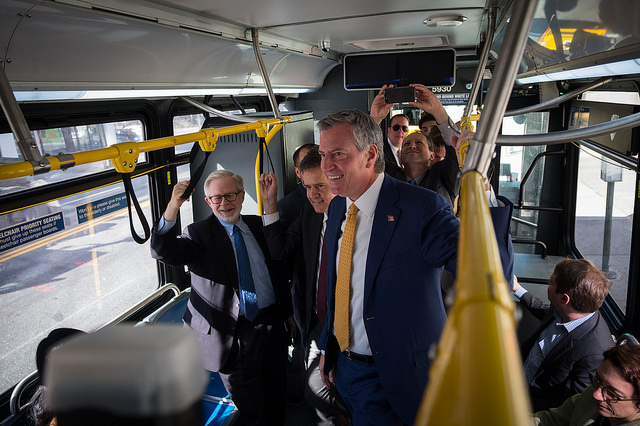"D" as in damn that's bad.
The city Department of Transportation and the NYPD nearly flunk out for their stewardship of the bus system, according to agency report cards released by the Bus Turnaround Coalition on Monday [PDF].
DOT got a D+ for its efforts to prioritize buses on city streets, while the NYPD got a D for its poor performance keeping bus lanes clear of parked vehicles and other obstructions.
"Mayor de Blasio’s Department of Transportation has a critical role to play in getting buses moving too, but has yet to commit to a serious plan to do so," the report says.
New York City's buses are the slowest in the nation, and ridership continues to decline more than two years since transit advocacy groups launched their bus campaign. In the first half of this year, bus speeds are down 4.5 percent from 2017 and ridership has dropped 5.4 percent, according to data compiled by advocates.
There is reason to be hopeful, however: the MTA's subways and buses chief Andy Byford's "Bus Action Plan" is currently moving ahead with a redesign of the Bronx's bus network. All-door boarding is in the works, and the agency's effort to improve bus dispatching has brought bus bunching down to 9.5 percent from 13.1 percent last year. In the Bus Turnaround Coalition report, the MTA didn't get any grade less than a B.
But the mayor, DOT, and NYPD have a key role to play as the administrators of the city's streets. So far, they're not rising to the challenge. The city's pace of bus lane and transit signal priority implementation remains unchanged, and bus lane enforcement has similarly stagnated.
For months, advocates have harped on the mayor's apparent disinterest in addressing the bus crisis. They've called on him to break out of the decade-old Select Bus Service model, a remnant of the Bloomberg administration, and install at least 60 miles of bus lanes on routes across the city before his term wraps up. They've also asked that transit signal priority be implemented with more urgency.
In response, the city has pointed to its continued expansion of Select Bus Service, seemingly missing the point of the coalition's call for the SBS toolkit to be implemented citywide.
"Since 2016 the Bus Turnaround Campaign has sought a bigger, faster program, urging the de Blasio administration to scale its efforts to the bus system and its crisis itself," said Jon Orcutt of TransitCenter. "We don't understand why the 'Fair City' administration won't step up on behalf of low-income commuters who are spending so much time (and more time as speeds decline) just trying to get to jobs and make other necessary trips."
Last month, the MTA revealed that it had nixed plans for new SBS routes until 2021. The suspension of the program should be an opportunity for the city to think big, advocates argue, but so far its playbook hasn't changed.
"The SBS program demonstrated that better bus service in the city is possible, but it was wholly insufficient to address the magnitude of the crisis facing bus riders on the city’s 246 local routes," the report says.
In response, DOT provided the following statement, which Orcutt called "lame propaganda" because some of it dates back to before de Blasio was even mayor:
The de Blasio administration has committed more for transit than ever before by committing to 20 new SBS routes, and has committed to bring SBS-style improvements to routes citywide through the Bus Forward program, and has:
- Worked with the MTA to implement SBS on 15 routes (on Oct. 1, 16), carrying over 375,000 riders, and achieving results like 10-30% faster travel times
- Implemented Transit Signal Priority at over 500 intersections, achieving results of up to 12-14 percent faster travel times
- Constructed over 75 bus bulbs and over 30 bus boarding islands
- Installed 60 miles of new bus lanes, and upgraded and additional 20 miles of bus lanes to better designs
- Installed 400 Real Time Bus Information signs in all five boroughs.
- This Administration has committed a total of roughly $270 million in new City funds to the SBS program.
In addition:
- The B82 SBS launches Monday Oct. 1 with five miles of new bus lanes, new bus routing to speed buses and changes to traffic signals and pedestrian safety.
- On Monday, Oct. 1, the bus lane mileage in NYC will increase from 106 to 111 miles.
Some of the projects completed or in progress this year include: Upgraded bus lanes on lower Broadway and Madison Ave in Manhattan
- Creation of a second bus lane on Fifth Avenue
- Extended bus lanes on Fulton Street, Brooklyn
- Traffic signal and operations improvements along Woodhaven Blvd in Queens (which speeds the bus)
- Planning and implementation of bus street priority along 14th Street and the future L train shuttles in Brooklyn and Manhattan
- Transit Signal priority implemented along Church Avenue, Brooklyn using a new streamlined analysis process
- Commitment to make at least 10 inaccessible bus stops accessible in 2018 – this goal has already been achieved
- The addition of bus boarding islands on Seventh Avenue in Manhattan






